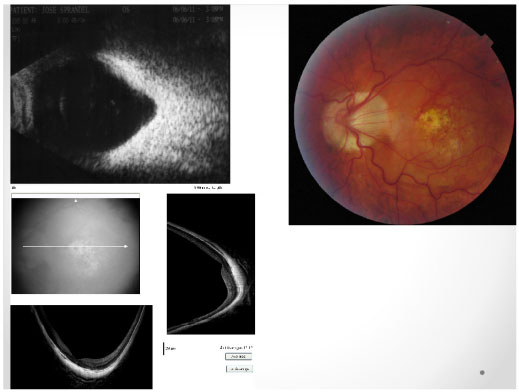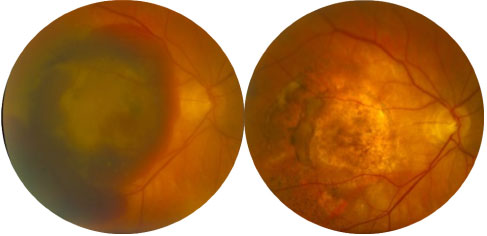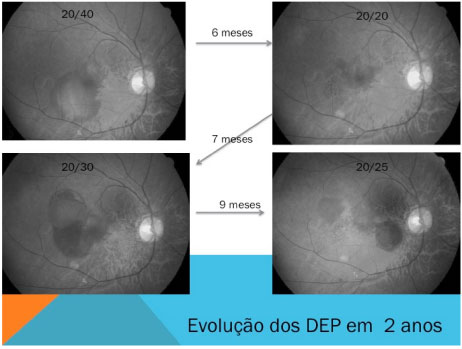Carlos Augusto Moreira Júnior
DOI: 10.17545/e-oftalmo.cbo/2016.57
ABSTRACT
Impressions on Gonin Club meeting in Bordeaux, France, 6-9 July 2016.
Keywords: Retina, Diabetic Retinopathy, Ophthalmologic, Surgical Procedures
RESUMO
Impressões sobre a reunião do Clube Gonin em Bordeaux, França, de 6 a 9 de julho de 2016.
Palavras-chave: Retina, Retinopatia diabética, Procedimentos cirúrgicos oftalmológicos
IMPRESSIONS AND ASSESSMENT:
1) Statins that lower cholesterol can help in the treatment of AMD
Miller et al. from the Harvard University have shown that high doses of statin medications used to control cholesterol levels decrease high-risk characteristics of macular degeneration, such as drusenoid deposits, and reduce the occurrence of wet macular degeneration. In this study, 26 patients who were taking 80 mg of atorvastatin (LipitorR) per day were followed up for 12–18 months. During the follow-up, none of these patients exhibited subretinal neovascularization, and 10 of them showed an improvement in vision.
2) Retinal pigment epithelium detachment (PED) that exhibits wrinkled changes has a better prognosis than elevated PED that exhibits smooth changes when treated with anti-VEGF
Mimoun et al. from the University of Paris-Est evaluated 29 eyes with wrinkled PED and 23 eyes with smooth PED that had been treated with anti-VEGF for 4 years. At the end of the follow-up, the vision was statistically better in the group with wrinkled PED (logMAR 0.36) compared with that in the group with smooth PED (logMAR 0.62), p = 0.01.
3) Posterior staphylomas in high-myopic eyes assessed based on wide-field and MR images
Ohno-Matsui et al. from the University of Tokyo evaluated 1060 eyes with axial myopia that exceeded 26.5 mm using 200° color images, 16 mm OCT, and 3D magnetic resonance imaging. Posterior staphylomas were detected in 55% of eyes, and wide macular staphyloma, which affects the entire posterior pole, was the most prevalent (79%), followed by narrow (15%), peripapillary (3%), and nasal staphylomas (2%). Furthermore, in 40% of the non-high-myopic eyes of patients with unilateral high myopia, posterior staphylomas were observed, showing that unilateral myopia can affect both eyes.

4) Treatment of submacular hemorrhage with injections of TPA and VPP
Avci et al. from the University of Izmir, Turkey, showed that cases with large subretinal hemorrhages in CNVM can be accurately treated within 3 weeks after the onset of symptoms. The VPP technique combined with a subretinal injection of anti-VEGF and 0.05 ml of r-TPA yields a good vision improvement. In this case, anti-VEGF should be used at the same dose as the intravitreal injection along with the filling of the vitreous cavity with 5%–60% C3F8.

5) OCT angiography in patients with reticular pseudodrusen
Eter et al. from the University of Muenster, Germany, demonstrated that patients with reticular pseudodrusen show a significant reduction in the vascular density and blood flow of the choriocapillaris layer, and consequently, the choriocapillaris plays an important role in the pathogenesis of the disease.
6) En-face OCT imaging of the photoreceptor layer in case of successfully operated macular holes
Yu et al. from the University of Seoul, Korea, analyzed 112 eyes with macular holes closed after surgery and conducted an en-face OCT of the ellipsoid zone before and after surgery for up to 1 year. They found that the presence of hyper-reflexive material in this area prior to surgery is indicative of poor visual prognosis.
7) Comparison of visual results in patients with the epiretinal membrane (ERM), with and without removal of the internal limiting membrane (ILM)
Ripandeli and Stirpe from the Bietti Foundation, Italy, assessed the results of 60 eyes with ERM for 24 months. In 30 eyes, both ERM and ILM were removed. At the end of the follow-up, less contrast sensitivity and a greater number of microscotomas in the central region were observed in the group in which the ILM was removed.
8) Online program to assess results of retinal detachment surgery
The BEAVRS group in the United Kingdom evaluated more than 3,000 cases of retinal detachment that were surgically treated in this program. They noticed that in cases where the macula was detached for up to 4 days, visual results were better than those in cases where the macula was detached for more than 4 days. The presence of grade C PVR and retinal detachment in 4 quadrants were associated with worse visual results.
9) Ozurdex in treating established PVR
Charteris et al. from the Moorfield Hospital, London, did not observe anatomical improvement in patients who underwent surgery for retinal detachment using PVR. Both Ozurdex and silicone oil were injected at the end of the VPP surgery in 140 eyes. This group attained full reattachment of the retina in 49% of cases, and the success rate in the control group was 46%.
10) Predictive factors for improved visual acuity in patients treated with anti-VEGF for diabetic macular edema (DME)
Augustin et al. from the University of Karlsruhe, Germany, evaluated 335 eyes with DME, which were treated with ranibizumab. They observed that if patients showed less than 20% improvement compared to the value at baseline in a 12-week period and after 3 injections, they will not respond well to injections comprising this anti-angiogenic.
11) Effect of vitreomacular adhesion (VMA) in the treatment of DME with ranibizumab
The READ study group evaluated the treatment of DME in 26 patients with positive VMA according to OCT. After 6 months, they observed that this group's visual acuity improvement was similar to that of the group without VMA. Therefore, the presence of VMA does not interfere in the treatment of DME using ranibizumab.
12) Visual results of polypoidal choroidal vasculopathy without immediate treatment

Ogura from the University of Nagoya, Japan, showed that treatment is not required for polypoidal lesions because they do not endanger the central vision. Only those with exudation or macular hemorrhage and with polyps larger than 400 microns should be treated with PDT and anti-VEGF.
13) Monosomy of chromosome 3 in patients with uveal melanoma
Bornfeld et al. from the University of Essen, Germany, compared the results of tumors from patients who had positive biopsies for melanoma and monosomy 3 to enucleate tumors from patients with monosomy 3. The biopsied tumors were smaller and subjected to early treatment with brachytherapy; despite exhibiting monosomy 3, there was a lower rate of metastases in these tumors than that in larger enucleated eye tumors.
14) Pneumatic vitreolysis in the treatment of focal VMT and macular hole stage 2
Chan and Mein from San Antonio, the United Sates, performed pneumatic vitreolysis in 33 eyes with focal VMT by injecting 0.3 ml of 100% C3F8. Patients were allowed to be in any position, except supine (face-up). DVP was observed in 88% of eyes treated with improved vision, which is a better outcome than that observed using an ocriplasmin injection.
15) Postoperative positioning for macular holes
Cour and Alberti from the University of Copenhagen, Denmark, studied 68 eyes with macular holes that were subjected to VPP surgery and C3F8 gas injection. Half the patients were maintained in a face-down position and the other half only avoided supination (face up). Results regarding hole closure (97%) and vision were identical. The variable that played the major role in hole closure was the amount of gas inside the eyeball on day 4 post-procedure. The greater the amount of gas, the greater the rate of macular hole closure.
16) Bevacizumab for the treatment of proliferative diabetic retinopathy
The Pan-American Collaborative Retinal Study Group found that eyes with PDR and prior panphotocoagulation could be well controlled with anti-angiogenic injections. Only 42% of the eyes without panphotocoagulation achieved control or regression of PDR after 24 months of follow-up.
17) Vitreous floaters
Sebag et al. from the United States studied 129 eyes with vitreous floaters and found that these objects diminished contrast sensitivity by 75%, leading to patient dissatisfaction. In all patients, VPP was performed using 25G, leaving the posterior vitreous humor to prevent cataract formation. After surgery, contrast sensitivity measured by the Weber index improved to 99%, leading to patient satisfaction with the procedure. We observed cataract formation in one eye and retinal detachment in the other one.
18) 3D Surgery
Toth et al. from Duke University demonstrated their experience with 3D surgery using Alcon Ngenuity equipment and intraoperative OCT. The practicality of this type of technique was remarkable along with reduced need for lighting during intravitreous and retinal procedures. OCT during the procedure accurately showed traction on the retinal tissue.
19) Pulmonary embolism caused by gas infusion during VPP
Albini et al. from Bascom Palmer, Miami, showed that if the infusion trocar remains in the suprachoroidal space, there is a possibility of acute pulmonary embolism due to the air passing into the vorticose veins. These authors established an animal model to study the problem and demonstrated that cases of sudden death during gaseous fluid exchange in vitreous-retinal surgery have occurred.
20 ILM Peeling in VPP for diabetic retinopathy
Romano from the University of Naples, Italy, observed that the number of intraretinal changes increases in diabetic patients undergoing VPP with peeling of the ILM, especially in the presence of intra-retinal cysts. The iatrogenic damage resulting from ILM peeling in patients with diabetic retinopathy is greater than that resulting from not peeling ILM.
SOURCE
XXX Meeting of the Club Jules Gonin. Bordeaux France. July 6-9, 2016. Final Programme. https://www.eyefox.com/3858/30th+Meeting+of+the+Club+Jules+Gonin.html

Funding source: None
Conflicts of interest: None
Received on:
July 29, 2016.
Accepted on:
August 1, 2016.